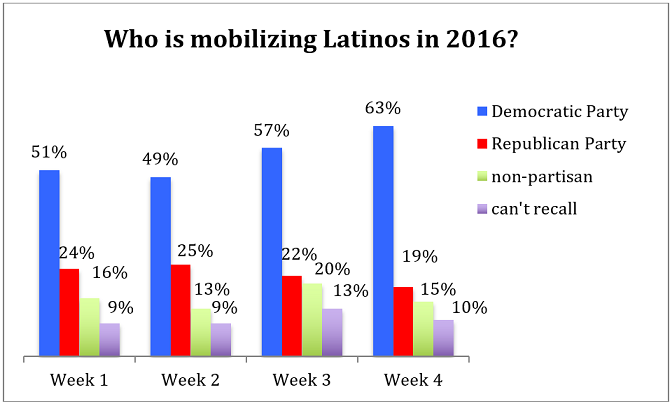There are an estimated 27 million Latinos eligible to vote in 2016. While Latinos constitute about 11 percent of the national electorate, their share significantly increases in battleground states such as Arizona (22 percent of the electorate), Colorado (14.5 percent), Florida (18 percent), Nevada (17 percent), New Mexico (40 percent) and Texas (28 percent).
The question in every election is whether Latinos will turn out to vote. In the 2012 election, there were an estimated 24 million eligible Latino voters. Yet, a mere 12.5 million voted. In other words, about half of the eligible Latino electorate voted in 2012.
A number of factors can explain why Latino turnout rates lag behind other Americans. Socio-demographic factors such as low rates of education, low levels of income, and a lower median age can significantly depress turnout. However, the social forces that depress turnout can be offset if an individual is mobilized to vote. Receiving a get-out-the-vote (GOTV) message can have a dramatic effect in boosting voter turnout. Regrettably, Latinos are not often the recipients of a GOTV message. Indeed, in this election a number of pundits have written about the lack of mobilization outreach efforts directed at Latino voters.
This is the fourth week of the Latino electorate tracking poll undertaken by Latino Decisions, the National Association of Latino Elected Officials Education Fund and Noticias Telemundo. This week we examine whether Latinos are being mobilized to turnout and vote. In addition to documenting the percent of Latino voters receiving a GOTV message, we can also determine the source of that message. Is it coming from the Democratic Party, the Republican Party, or a non-partisan organization?
Latinos were asked, “So far in this election, has anyone from a political party, campaign or any other organization contacted you and asked you to register or vote? Either by knocking on your door, calling you, sending you something in the mail, by e-mail or text, or while you were out in the community?” We see in Figure 1 that about 40 percent of Latinos have received some type of GOTV message.
At first glance that may seem low, but it is important to keep in mind that this is a national poll, and a significant portion of Latinos reside in non-battleground states. Candidates and political parties typically do not engage in GOTV efforts in safe states like California or New York, but rather target voters in battleground states. Later we will report in detail the results of a poll on Latinos residing in battleground states, where we anticipate seeing significantly higher levels of GOTV targeting.
Clearly Latinos are receiving GOTV messages. But who is targeting Latino voters?
We asked those who received GOTV messages to identify who contacted them and the responses overwhelmingly attribute the outreach to the Democratic Party. Across the four weeks of our polling, we also see a dramatic increase in targeting by the Democrats. In contrast, Republican Party mobilization efforts are significantly smaller and appear to be declining over time.

Latinos will turnout in record numbers if they are mobilized by the candidates, parties or other groups. Nationally, a significant number of Latinos are being encouraged to vote. We anticipate finding that Latinos in battleground states are being mobilized at even higher rates. The primary source of that encouragement is coming from the Democratic Party: If they continue to target Latinos, we suspect the payoff will be great as these efforts will drawn in record numbers of Latinos on Election Day.
Adrian D. Pantoja, Ph.D., is senior analyst with Latino Decisions and professor of Politics at Pitzer College.

